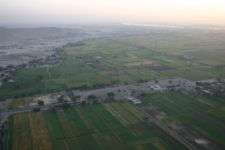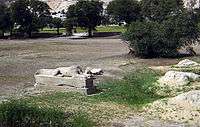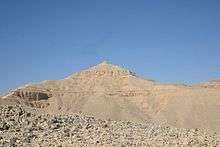Mortuary Temple of Amenhotep III

The Mortuary Temple of Amenhotep III, also known as Kom el-Hettân, was built by the main architect Amenhotep, son of Habu, for the Pharaoh Amenhotep III (or Amenhetep III) during the 18th Dynasty in the New Kingdom (Kozloff and Bryan). The mortuary temple is located on the Western bank of the Nile river, across from the Eastern bank city of Luxor (Kozloff and Bryan). During its time, the Mortuary Temple of Amenhotep III was the largest funerary complex in Thebes that was built (Kozloff and Bryan).
Currently, only parts of the mortuary temple’s layout remains, as well as the Colossi of Memnon, which are two large stone statues placed at the entrance measuring 18 meters (59 feet) high (Wilkinson). Because the mortuary temple was built relatively close to the river, the annual flooding caused the site to decay at a more rapid rate over time. The Colossi of Memnon and Amenhotep III Temple Project have helped conserve the site as well as possible (Sourouzian-Third Report).
Excavation History
Dr. Hourig Sourouzian was the main excavator in the early 2000s and the site was visited by Dr. Zahi Hawass, although the mortuary temple was previously excavated in the late 1900s as well. Laurent Bavay examined the pottery found at the site from the 1999-2002 excavation seasons. The Hypostyle Hall was cleared by Myriam Seco Alvarez. (Sourouzian-Third Report)
Temple layout


The temple faced to the East, which is most likely due to the sun rising in the East, since Amenhotep III revered the sun god Amun-Re. At the front of the mortuary temple, the Colossi of Memnon can be found, and as one enters, the long Hypostyle Hall leads to the Peristyle Sun Court, and the whole area is surrounded by three pylons, also known as gates (Sourouzian-Third Report). The Sun court is divided into the North and South halves and consisted of statues of both Amenhotep III and the gods. The North side had statues made of brown quartzite from Lower Egypt, while the South side had red granite from Aswan in Upper Egypt (Kozloff).
Major Findings and their Significance
Some of the pottery examined by Laurent Bavay were ring-based cups, beer jars, and wine amphorae, which were mainly found in the Peristyle Sun Court and Third Pylon (Sourouzian-Third Report). Some stelae were found at the entrance of the Sun Court, which may have described the pharaoh’s building accomplishments. There are hundreds of freestanding statues, sphinxes, and massive stelae throughout the mortuary temple. Some of these include: numerous statues of Sekhmet (lion-headed goddess), animals (such as lion-crocodile sphinx, jackals, scarabs beetles, and a white hippopotamus), Egyptian gods, and Amenhotep III as a god (Kozloff). Dr. Betsy Brian suggests that Amenhotep III may have organized the animal and Sekhmet statues into maps of the heavens, therefore bringing the heavens to Earth (Kozloff). As for the white hippopotamus, archaeologists are unsure of what it represents since there are no written documents or evidence that suggest its purpose, although some have guessed that it was used as some form of ritual (Sourouzian-Fourth Report). Some Sekhmet statues are standing, some are sitting, while some are holding a papyrus scepter on left hand, and the symbol of life on the right hand. Why are there hundreds of Sekhmet statues? Jean Yoyotte suggests that the goddess Sekhmet is given importance because not only is she the “mistress of drunkenness’, but she provides healing qualities, which are meant to cure any illnesses of Amenhotep III. Also, she played an important role in the royal jubilee in order to “protect the sun-king against the enemies of the sun” (Sourouzian-Fourth Report).
Having building materials from both Upper and Lower Egypt was a way Amenhotep III established sema-tawy (unification) of both lands. He also establishes Ma'at (justice and peace) over Islet (chaos) by having the statues of fauna, and therefore having control over them, as well as having depictions of bounded Egyptian enemies (such as the Nubian, Asiatics, Mesopotamians, Aegeans, Hittites, etc.) by some of the many statues of himself.
The whole temple also symbolizes a mound and the “emergence of the world from the primeval waters of creation” every time the Nile river flooded the temple, since the Egyptians believed that the Earth was formed by a mound emerging from the water (Wilkinson). Amenhotep III wanted to be revered as a god on Earth, not just in the afterlife once he is dead. He builds this enormous mortuary temple to leave a legacy that he was a living god who ruled on Earth.
The Temple's Future
Dr. Zahi Hawass, Mansour Boraik, Ali el-Asfar, and Ibrahim Soliman want to bring back the artifacts and findings from the Mortuary Temple of Amenhotep III to the original site, since they are dispersed in different museums. They hope to form an open-air museum, and to eventually bring awareness of the importance of on-site conservation.
See also
- Colossal quartzite statue of Amenhotep III Found at the Mortuary Temple
- Medinet Habu (Mortuary Temple of Ramesses III)
- Colossi of Memnon, two massive statues built nearby
References
1) Kozloff, Amenhotep III: Egypt’s Radiant Pharaoh. 2012.
2) Kozloff and Bryan, Egypt’s Dazzling Sun: Amenhotep III and his World. 1992.
3) Sourouzian, Hourig, Rainer Stadelmann, Myriam Seco Alvarez, Josef Dorner, Nairy Hampikian, and Ibrahim Noureddine 2007. The temple of Amenhotep III at Thebes: excavations and conservation at Kom el-Hettân. Fourth report on the sixth, seventh and eighth season in 2004, 2004 - 2005 and 2006. Mitteilungen des Deutschen Archäologischen Instituts, Abteilung Kairo 63, 247-335.
4) Sourouzian, Hourig, Rainer Stadelmann, Myriam Seco Alvarez, Laurent Bavay, Helmut Becker, Philippe Bromblet, Mourad El-Amouri, Samia Emara, Jens Linke, Frédéric Pernel, Franz Schubert, Mary Schubert, and Fritz Wenzel 2004. The temple of Amenhotep III at Thebes: excavation and conservation at Kom el-Hettân. Third report on the fifth season in 2002/2003. Mitteilungen des Deutschen Archäologischen Instituts, Abteilung Kairo 60, 171-236.
5) Wilkinson, The Complete Temples of Ancient Egypt. 2000.
External links
Coordinates: 25°43′16″N 32°36′36″E / 25.721°N 32.610°E
